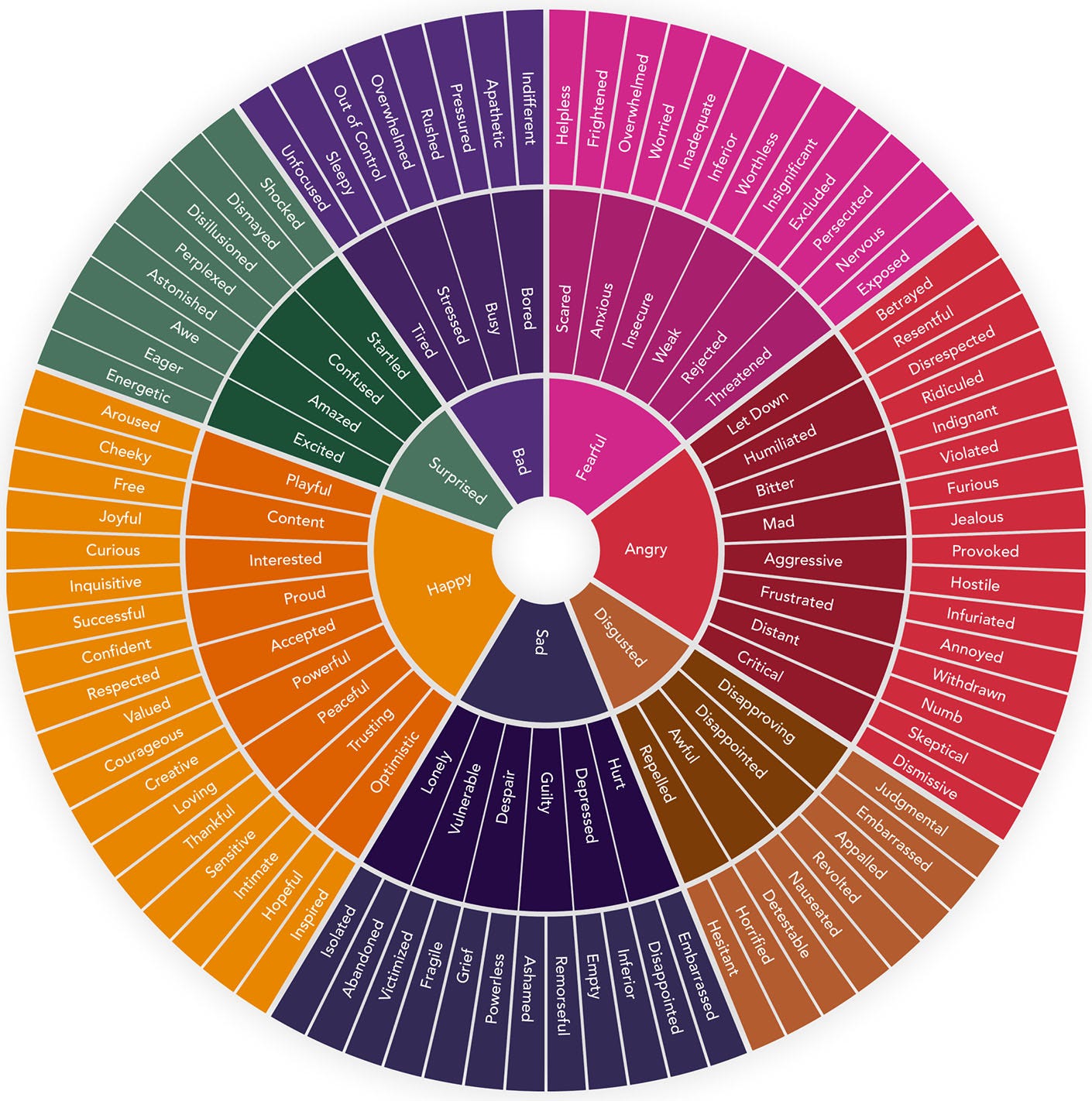3 ways to sit with a feeling until the insight tumbles out (part 2)
Way #2: Juxtapose the feeling want + the situation you have, and let your brain fill in the gap 🧩
Last week, we started our series: 3 ways to sit with a feeling until the insight tumbles out.
(If you haven’t already, check out the introduction and Way #1!)
Like I told you in the introduction, I like to think of feelings like eggs.
Just like an egg contains an unhatched chick…
Every feeling contains within it an unarticulated insight.
And your job is to incubate the “feelings egg” until the insight hatches out 🐣
You can do this with the feeling you’re currently feeling (that’s what Way #1 was about).
But you can also do this with the feeling you WANT to feel.
That’s what Way #2 is about—
Way #2: Juxtapose the feeling want + the situation you have and let your brain fill in the gap
Here’s a step-by-step breakdown of how you do this:
Step 1: How do you want to feel?
Take your time to identify how you want to feel.
Go beyond “happy” or “good.”
Do you want to feel purposeful? Capable? Powerful? Free?
Maybe even neutral? Or playful? Or brave? Or curious?
If helpful, use the Feelings Wheel (below) as a word bank to find the feeling you want to feel. (You can see a full-size version at feelingswheel.com.)
Step 2: What physical sensations and movements does that emotion create in your body?
Every emotion creates physical sensations in your body.
We literally feel our feelings in our body.
Our emotional experience is so closely tied to our physical experience that the English language uses the same word for both things — “feeling.”
You can feel an emotion and you can also feel a physical sensation.
And as you read each “emotion word” on the Feelings Wheel, you can probably feel a little micro-dose of the physical sensations that that emotion creates in you.
“Amazed. Confused. Aggressive. Guilty.”
Pay attention to your body as you say those words, and you’ll notice that each emotion-word creates a slightly different physical sensation in your body.
Every emotion creates physical sensations.
So here’s what I want you to do.
For the emotion that you want to feel — the emotion you picked in Step 1…
Hold that “emotion word” in your mind and really notice the physical sensations and movements in creates in your body.
You can even exaggerate the physical sensations and movements and “make them big” so you can really notice them.
For example, “aggressive,” makes me clench my teeth, frown, and lean forward in my chair. I also feel a sensation of pressure in my chest.
“Amazed” makes relax my mouth, soften my eyebrows, sit back in my chair, and look upward. I also feel a warm, settled sensation in my chest and shoulders.
Really let the emotion-word land for you. Let it sink into your brain. Hold it in your mind the way you would hold a piece of hard candy in your mouth.
And notice the physical sensations and movements it creates in your body.
Really notice the physical impression of that emotion in your body.
Make it big and exaggerate it — as if you were miming the emotion — so you can really observe it.
This is your physical bookmark for that emotion.
This is how you find the emotion again if you need it.
Because your brain associates that physical sensation and movement with that emotional experience very, very closely.
So if you can find that physical sensation and movement again, you can find the emotion again.
Step 3: Look at the situation in front of you WHILE holding that emotion-word in your mind and holding that emotion’s physical sensations in your body
Let’s say your to do list usually makes you feel overwhelmed.
But the feeling you would LIKE to feel is capable (that’s Step 1 — identify the feeling you want to feel).
You’ve identified the physical sensations and movements that your brain associates with the emotion of “capable” (that’s Step 2).
Maybe “capable” makes you sit up straight and focus your eyes and feel a sensation of grounded-ness in your core. That’s the physical bookmark for that emotion.
Now, look at your to do list WHILE holding the word “capable” in your mind and holding those physical sensations in your body.
(And when I say “holding those physical sensations in your body” — think of it like if you were in a workout class and the trainer told you “do the lunge again but this time, engage your core while you do it.”
“Hold that emotion’s physical sensations in your body” is just like “engage your core while you do that lunge.”
Except instead of engaging your core, you’re engaging those physical sensations of that you bookmarked in Step 2.)
And then…
Once you’re looking at the circumstance in front of you WHILE holding the emotion you want to feel in your mind and your body…
Just wait. Let your brain fill in the gap.
Because what you’re doing here is you’re creating a surprising juxtaposition for your brain.
Your brain is very used to looking at your to-do list and feeling overwhelmed…
But you’re creating a new juxtaposition.
You’re looking at the same to-do list…
But you’re juxtaposing it with the word “capable” in your mind and with the physical sensations your brain associates with the emotion of “capable” in your body.
And when your brain is faced with a surprising juxtaposition, it has to create new thoughts in order to make sense of it.
And so when you hold that juxtaposition…
Your brain will come up with a new idea for how to handle your to-do list.
It will come up with a new perspective you hadn’t seen before.
Your brain will say, “Well, let’s just move these things to tomorrow and focus on those things today. Okay, that works.”
Or it will say, “What if we use that meeting to get their input and brainstorm together? Then we don’t have to prepare as many materials for it.”
Or it will say, “You know what’s a quick and dirty way to get that initiative started? Let’s just make a list of bullets and email it over and get the conversation going. We can make the whole presentation later.”
Take your time. Your brain may not fill in the gap instantaneously.
But just wait, hold the juxtaposition, and let your brain figure it out.
When you juxtapose the feeling you want with the circumstances you have…
Your brain has no choice but to fill in the gap.
Your brain will generate new solutions, new helpful perspectives, and new creative paths forward on its own…
Just because it’s trying to make this juxtaposition make sense.
So just keep the circumstance in front of you…
While holding this emotion-word in your mind and these physical sensations in your body…
And let your brain fill in the gap.
This is the technique I’ve been using the most these days.
The emotions I want to feel are…
Helpful.
Connected.
Generative.
(I know that’s not really an emotion, but in my mind, it’s kind of a combo of powerful + creative.)
And all day long, I hold one of these emotions in my mind and my body while I look at the situation in front of me.
Awkward gathering where I don’t know anyone?
I hold “connection” in my mind and the associated physical sensations in my body and let my brain fill in the gap.
And suddenly, my brain has ideas for how I can connect with the people around me.
I want to tell someone that I think they could benefit from coaching, but I don’t want to be pushy or sales-y?
I hold “helpful” in my mind and the associated physical sensations in my body and let my brain fill in the gap.
And suddenly, my brain has ideas for what I can say.
I’m staring at the blank screen and wondering what the heck I’m going to write today, and kind of feeling like I have no ideas left?
I hold “generative” in my mind and the associated physical sensations in my body and let my brain fill in the gap.
And suddenly, I had a bunch of ideas for how I wanted to write this piece.
I love this technique because it is so simple and lightweight.
You don’t have to refer to a 50 page manual to implement it.
You don’t have to do a ton of extra work or put in a lot of conscious effort.
You just have to hold the juxtaposition and let your brain do the rest.
Identify the emotion you want to feel.
Find the physical sensations your brain associates with that emotion.
And then juxtapose the circumstances in front of you with that emotion + sensation.
And your brain will do the rest of the work for you.
And if you run into any trouble, come talk to me.
Coaching is about building a strong, fun, trusting partnership with your own brain.
My articles give you one technique at a time, for doing this.
When you work with me, I give you the whole toolbox at once.
And most importantly, I work with you one-on-one to help you implement it.
And by the time we’re done, you and your brain will have become partners and friends…
And you will…
Almost as a byproduct of that strong working relationship with your brain…
End up creating the life you actually want.
Let’s start today.
What my clients have to say…
“My general happiness levels are higher. I have coping mechanisms during stress. My husband is seeing the results of it — I have a better married life with him.
Coaching has given me more inner peace and focus as to what are the things that I want and how to go after them without setting ceilings. And it’s allowed me to get to the root of what it is that I want, and not just chase the next big thing.”
—Client | CEO, PE-backed company
Did you know I have a full table of contents, where all my work is categorized by topic, so you can easily find what you need right now? Check it out below! :)
💻 Website | 📸 Instagram | 🎧 Podcast | 💌 Newsletter | 👋🏽 Free resources




